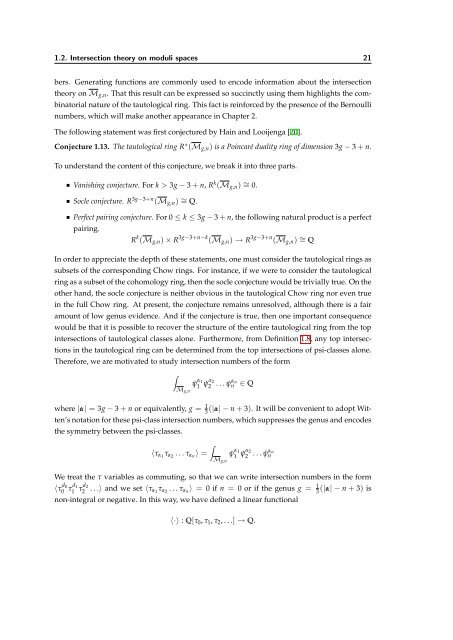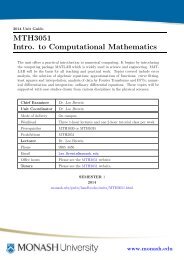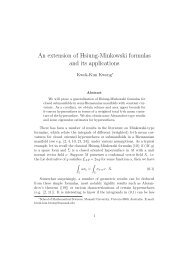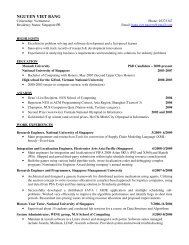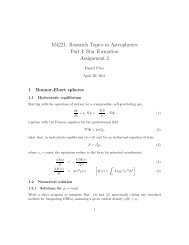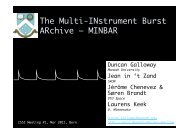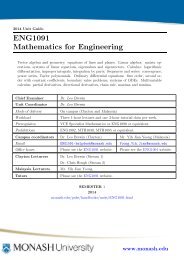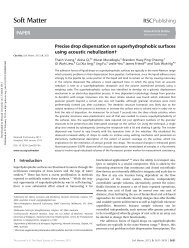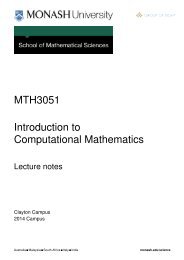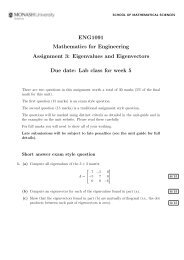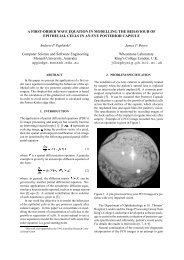Intersection theory on moduli spaces of curves ... - User Web Pages
Intersection theory on moduli spaces of curves ... - User Web Pages
Intersection theory on moduli spaces of curves ... - User Web Pages
Create successful ePaper yourself
Turn your PDF publications into a flip-book with our unique Google optimized e-Paper software.
1.2. <str<strong>on</strong>g>Intersecti<strong>on</strong></str<strong>on</strong>g> <str<strong>on</strong>g>theory</str<strong>on</strong>g> <strong>on</strong> <strong>moduli</strong> <strong>spaces</strong> 21bers. Generating functi<strong>on</strong>s are comm<strong>on</strong>ly used to encode informati<strong>on</strong> about the intersecti<strong>on</strong><str<strong>on</strong>g>theory</str<strong>on</strong>g> <strong>on</strong> M g,n . That this result can be expressed so succinctly using them highlights the combinatorialnature <strong>of</strong> the tautological ring. This fact is reinforced by the presence <strong>of</strong> the Bernoullinumbers, which will make another appearance in Chapter 2.The following statement was first c<strong>on</strong>jectured by Hain and Looijenga [20].C<strong>on</strong>jecture 1.13. The tautological ring R ∗ (M g,n ) is a Poincaré duality ring <strong>of</strong> dimensi<strong>on</strong> 3g − 3 + n.To understand the c<strong>on</strong>tent <strong>of</strong> this c<strong>on</strong>jecture, we break it into three parts.Vanishing c<strong>on</strong>jecture. For k > 3g − 3 + n, R k (M g,n ) ∼ = 0.Socle c<strong>on</strong>jecture. R 3g−3+n (M g,n ) ∼ = Q.Perfect pairing c<strong>on</strong>jecture. For 0 ≤ k ≤ 3g − 3 + n, the following natural product is a perfectpairing.R k (M g,n ) × R 3g−3+n−k (M g,n ) → R 3g−3+n (M g,n ) ∼ = QIn order to appreciate the depth <strong>of</strong> these statements, <strong>on</strong>e must c<strong>on</strong>sider the tautological rings assubsets <strong>of</strong> the corresp<strong>on</strong>ding Chow rings. For instance, if we were to c<strong>on</strong>sider the tautologicalring as a subset <strong>of</strong> the cohomology ring, then the socle c<strong>on</strong>jecture would be trivially true. On theother hand, the socle c<strong>on</strong>jecture is neither obvious in the tautological Chow ring nor even truein the full Chow ring. At present, the c<strong>on</strong>jecture remains unresolved, although there is a fairamount <strong>of</strong> low genus evidence. And if the c<strong>on</strong>jecture is true, then <strong>on</strong>e important c<strong>on</strong>sequencewould be that it is possible to recover the structure <strong>of</strong> the entire tautological ring from the topintersecti<strong>on</strong>s <strong>of</strong> tautological classes al<strong>on</strong>e. Furthermore, from Definiti<strong>on</strong> 1.8, any top intersecti<strong>on</strong>sin the tautological ring can be determined from the top intersecti<strong>on</strong>s <strong>of</strong> psi-classes al<strong>on</strong>e.Therefore, we are motivated to study intersecti<strong>on</strong> numbers <strong>of</strong> the form∫ψ α 11M ψα 22 . . . ψα nng,n∈ Qwhere |α| = 3g − 3 + n or equivalently, g =3 1 (|α| − n + 3). It will be c<strong>on</strong>venient to adopt Witten’snotati<strong>on</strong> for these psi-class intersecti<strong>on</strong> numbers, which suppresses the genus and encodesthe symmetry between the psi-classes.∫〈τ α1 τ α2 . . . τ αn 〉 = ψ α 11M ψα 22 . . . ψα nng,nWe treat the τ variables as commuting, so that we can write intersecti<strong>on</strong> numbers in the form〈τ d 00 τd 11 τd 22 . . .〉 and we set 〈τ α 1τ α2 . . . τ αn 〉 = 0 if n = 0 or if the genus g = 1 3(|α| − n + 3) isn<strong>on</strong>-integral or negative. In this way, we have defined a linear functi<strong>on</strong>al〈·〉 : Q[τ 0 , τ 1 , τ 2 , . . .] → Q.


